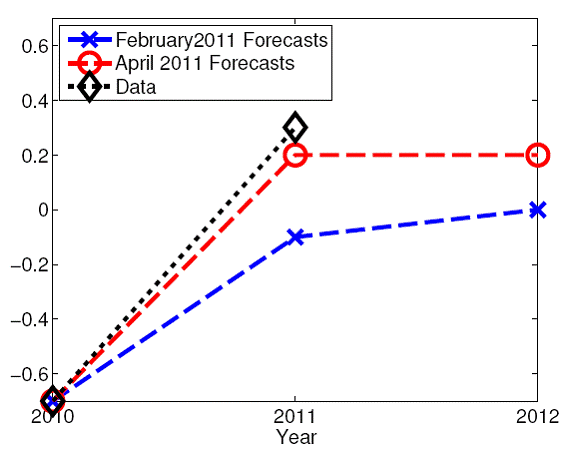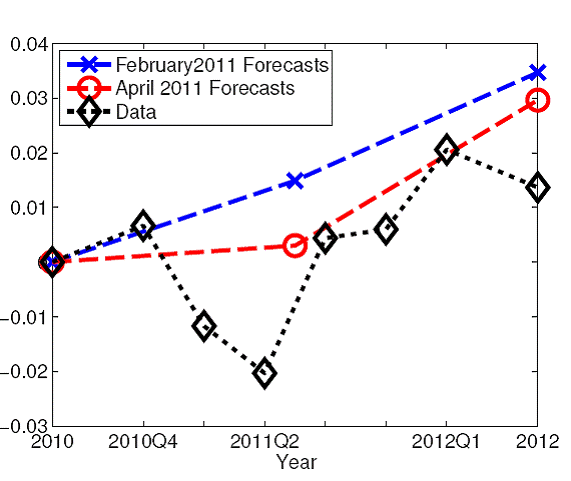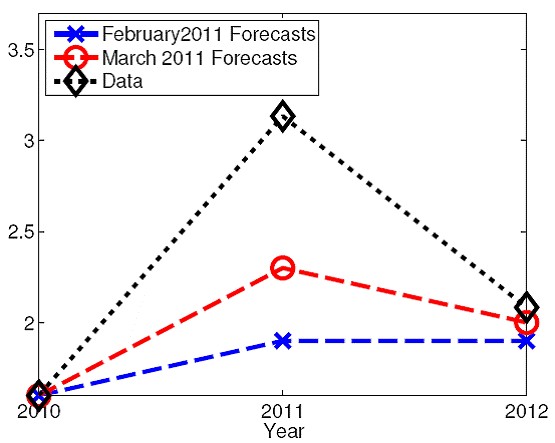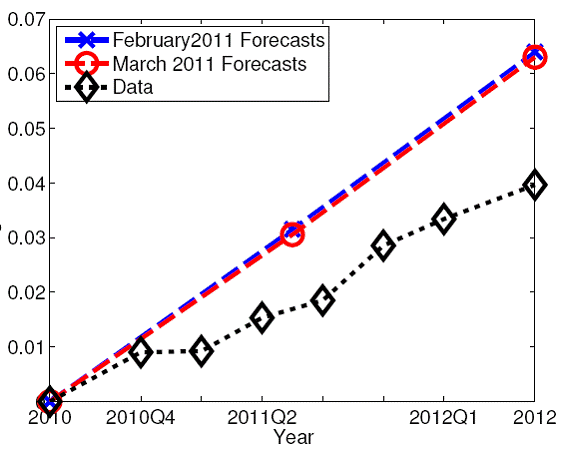According to one widely adopted class of economic models, raising the inflation rate would be one of the most helpful things that could happen to economies in the situation currently faced by Japan and the U.S. Here I describe some new research relevant for testing that theory.
With the short-term interest rate stuck near zero at the moment for the United States and Japan, an increase in expected inflation would mean a reduction in the expected real interest rate. According to a wide class of economic models, such a development should help boost total spending and help the economy to grow more quickly.
One extreme, if less widely accepted, implication of that claim is that even policies that reduce the overall productive potential of the economy might actually prove to be beneficial insofar as they result in higher inflation. Examples include increasing the monopoly power of firms and labor unions, raising payroll taxes, or even the more crazy-sounding policies adopted as part of the New Deal in the 1930s, such as killing baby pigs and destroying good fruit in hopes of getting higher prices for farmers. Although many economists would hesitate to embrace such proposals as constructive policy measures, their potential usefulness is a logical implication of a very popular class of economic models, as demonstrated for example in recent research by Gauti Eggertsson of the Federal Reserve Bank of New York.
New research by Johannes Wieland proposes some neat ways to test that theory. Johannes is a graduate student at the University of California at Berkeley who I’m delighted to report will be joining the faculty at UC San Diego this fall. Johannes notes that there are a number of natural experiments that have been run with which we could test Eggertsson’s hypothesis.
One example is the Japanese Great Earthquake of 2011. What happened when a powerful tsunami took out a lot of Japanese productive capabilities? It certainly raised expectations of inflation in Japan, as one can see in the graph below of the rates of inflation that market analysts were expecting for Japan both before and after the earthquake.

Consensus Economics forecasts of Japan year-over-year CPI inflation from before earthquake (in blue) and after (in red), along with the actual realized outcome (in black). Source: Wieland (2013).
And was that helpful for Japan’s GDP? The clear answer is no.

Consensus Economics forecasts of Japan GDP from before earthquake (in blue) and after (in red), along with the actual realized outcome (in black). Source: Wieland (2013).
Another example that Johannes considers is oil supply disruptions coming from events such as the civil unrest in Libya in 2011. Again, this proved to be a shock that increased expected inflation in places like the U.S.

Consensus Economics forecasts of U.S. year-over-year CPI inflation from before Libyan uprising (in blue) and after (in red), along with the actual realized outcome (in black). Source: Wieland (2013).
And again, the actual behavior of U.S. GDP relative to what forecasters had been predicting prior to the crisis can hardly be described as a welcome development.

Consensus Economics forecasts of U.S. GDP from before Libyan uprising (in blue) and after (in red), along with the actual realized outcome (in black). Source: Wieland (2013).
Johannes draws on a lot of other evidence, looking more broadly at other fluctuations in oil production and prices, experience across different countries, and some ingenious evidence based on the behavior of the inflation risk premium. His overall conclusion is that adverse supply shocks have undesirable effects for economies even when they are at the interest rate zero lower bound.
Johannes attributes this failure of many mainstream models to their simplistic specification of the role of interest rates. He proposes a model with richer financial frictions. When consumers borrow at a different interest rate from the federal government, it is no longer appropriate to talk about what a given development does to “the” real interest rate. Johannes finds that models with these kind of financial frictions generate the more sensible (and data-coherent) implication that adverse supply shocks are, well, adverse.
However, Johannes notes that when you modify this feature of popular models, some of the other, less controversial implications of the models are also called into question. For example, there is a broad consensus among economists that expansionary fiscal policy may be a particularly effective policy tool for an economy at the zero lower bound, in part because it’s another device that may succeed in raising inflationary expectations. His study concludes:
In any data-consistent model the rise in inflation expectations from higher marginal costs cannot be expansionary, so that fiscal policy becomes much less effective. Consequently, in the calibrated model with credit frictions, demand-side policies are up to 50% less effective than in a standard new Keynesian model. This suggests that policy makers should be cautious in expecting large positive outcomes from such policies at the ZLB.



Leave a Reply